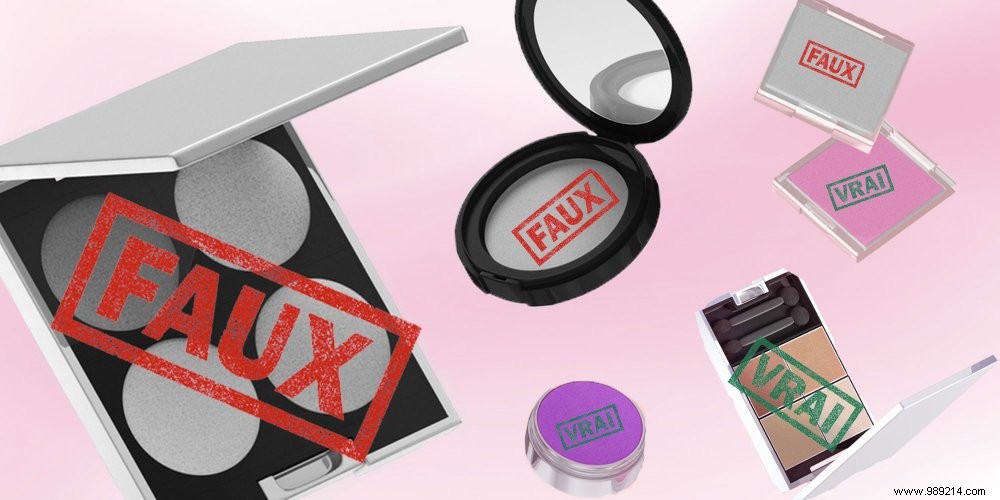 Little is known, but the cosmetics sector is one of the most affected by counterfeiting. How are these fraudulent products marketed, how to recognize them and avoid being deceived?
Little is known, but the cosmetics sector is one of the most affected by counterfeiting. How are these fraudulent products marketed, how to recognize them and avoid being deceived? According to seizures made by customs in 2021, among the 9.1 million counterfeit items, personal care products came first ahead of games, toys, sporting goods and clothing with more than 1.7 million products seized. An increase of +482% compared to the previous year, driven by the boom in e-commerce during the Covid-19 pandemic.
At the heart of the category of counterfeit body care products, perfumes and cosmetics are the products that have been seized the most. Big favorite of fake and imitations (known as dupes ):the make-up palette. This is the scourge of trendy brands, like Anastasia Beverly Hills, Huda Beauty, Kylie Cosmetics, Urban Decay or Morphe, who see thousands of counterfeits of their products flooding the Internet.
A real shortfall for brands that are reluctant to communicate on this thorny problem. In 2019, the EUIPO (European Union Intellectual Property Office) estimated in a report that approximately 10.6% of sales in the cosmetics and personal care sector (7 billion euros) are lost each year in the European Union due to the presence of counterfeit products. In France, this figure is 9.3%, or 1.2 billion euros of lost revenue each year.
Video of the day:But it is above all a real problem for the safety of deceived consumers if the products contain toxic substances. "An uncontrolled cosmetic product can be dangerous for the skin and cause an allergy , no dermatological test being carried out and no information on allergens appearing on the packaging, we explain within the FEBEA (Federation of Beauty Companies). Not to mention that the manufacture of a counterfeit product can be carried out by unskilled labor, without any respect for the most basic hygiene rules, using poor quality or even prohibited ingredients. by regulation."
Read also:Without parabens, anti-wrinkle... What beauty brands can no longer sayIt is difficult and the brands themselves must resort to meticulous comparisons in certain particularly well-imitated cases. It is especially necessary to be vigilant with the packaging but also with the place of purchase and the price which should not seem fanciful. In stores, it is possible to spot a copy by tracking down spelling errors on the packaging, or by looking if the printing is of poor quality.
Finally, for a perfume, the smell and the color can also betray the deception. Another unmistakable sign:perfumes are marketed in approved networks (perfumers, selective department stores, etc.). If they are sold on the market on Sunday morning:distrust.
For online shopping enthusiasts, it is better to favor known networks or brand e-shops rather than social networks or second-hand sites.
"Manufacturers of selective products only authorize their authorized distributors to sell perfumes on the Internet if they meet their accreditation criteria, indicates the FEBEA. They must have a physical point of sale and their Internet site must be of sufficient quality. , particularly in terms of advice. Selling on the Internet is therefore a natural extension of in-store sales, to the benefit of the user who can thus choose where to make his purchase."
To combat the scourge of counterfeiting, a charter was drawn up in 2009 which commits each signatory to setting up concrete means to combat the sale of counterfeit products on the Internet, with better control of the products offered for sale on the Internet. signatory platforms.
This anti-counterfeiting system has been extended to other e-commerce players participating in spite of themselves in the distribution of counterfeit products on the Internet, such as classified ad sites or intermediary players such as postal operators.
The goal:to implement new preventive measures for the detection of con
Read also:The new Beauty entrepreneurscounterfeits, more easily remove a counterfeit product from sale and better manage reports from consumers who are victims of counterfeiting on the Internet
These are skincare or make-up products that resemble both in color and texture a product from a well-known brand. However, the packaging is very different from the original product, so we cannot say that it is a "fake".
The fact remains that these products are derivatives of counterfeiting. On the Internet, lists of dupes abound on unscrupulous blogs, but there again distrust. If the result seems close to the real copied product, at least as far as makeup is concerned, the dupes do not have the same composition as their model, which sometimes results from several years of R&D.